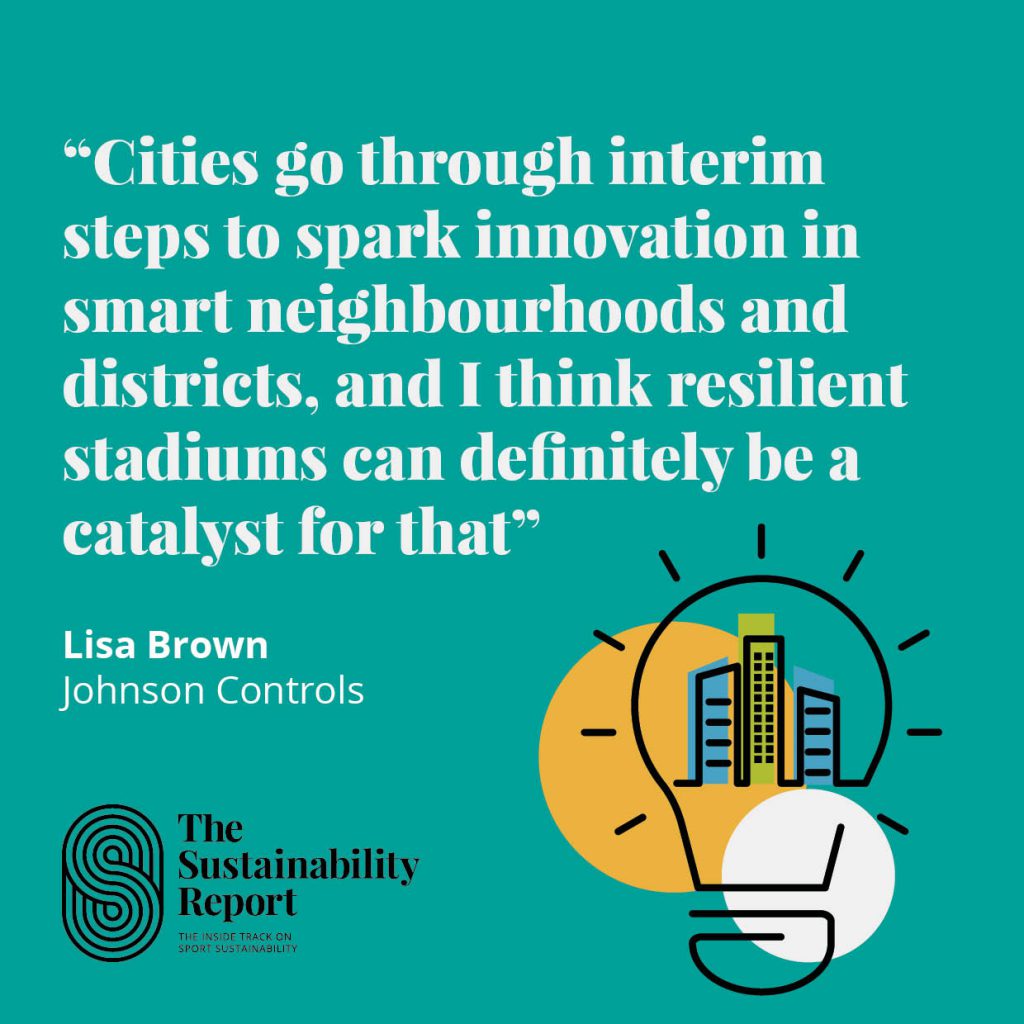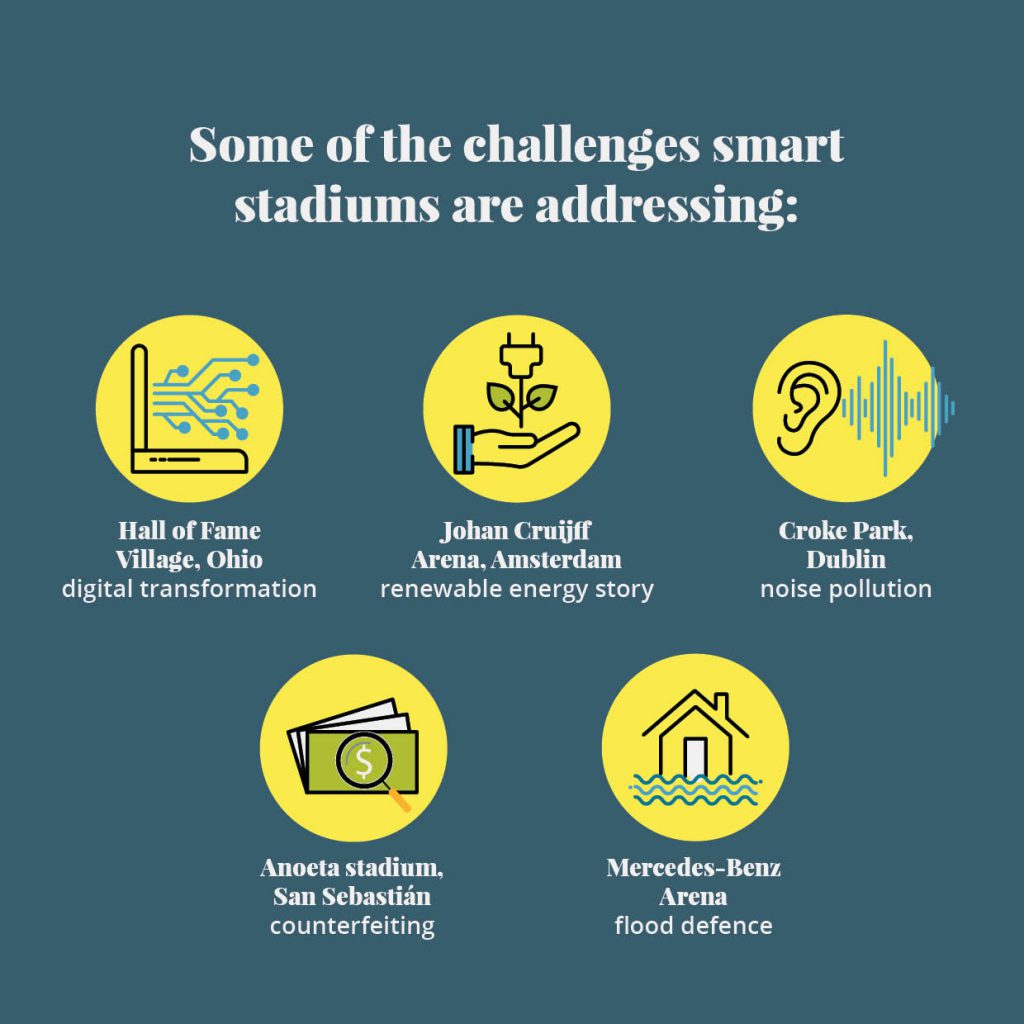Once the cathedrals of modern times, some stadiums have become awkward structures in their communities. Could a focus on innovation and sustainability reinvigorate both venue and city?
Stadiums, if they were people, would currently find themselves in a peculiar position. Despite being essential for top-level sport, these structures have, generally speaking, gone from being the darling of the sports industry – the cathedrals of modern times – to somewhat awkward buildings that many owners and operators struggle to monetise effectively.
While it has always been true that many sports venues stand dormant for a significant periods of time, even on matchdays several stadiums now struggle to get the desired amount of people excited enough to entice them through the door and spending money.
It was noted in Sports Innovation Lab’s latest report, ‘Designing breakthrough experiences’, that sports events are no longer the only game in town for consumers. ‘Smart venues’ that make attending games more convenient and fun are the only way to compete with the alternative entertainment vying for their attention.
This trend has not gone unnoticed. According to a recent market research report, the smart stadium market was valued at $5.6 billion in 2018, and is projected to expand by 20% by the end of 2025.
Forward-thinking stadium owners and operators are spending significant amounts of time and money on the latest technologies to improve the fan experience. But it doesn’t stop there; innovations related to sustainability, security and transport are making these buildings more efficient and safe.
Much of this begs the question: while the urban centres around them grapple with the logistical challenges of digital transformation and sustainable development in densely-populated areas, to what extent can the stadium be reinvented as the nucleus or testbed for smart cities?
What is a smart city?
By 2050, two-thirds of the world’s population will be living in urban areas. With that increase comes a number of significant challenges around transport, accommodation, healthcare, sustainability and resiliency, social inclusion, and education.
Progressive local authorities and municipalities know what’s on the horizon, and are beginning to integrate the technology they need to transform into smart cities. Often, this involves leveraging a network of internet of things (IoT) sensors to collect data about the city’s services with a view to making improvements.
Lisa Brown, the national senior director of strategy, local government and municipal infrastructure at Johnson Controls, says, at one point, she counted “29 different definitions” for smart cities. But, essentially, being smart comes down to three things: security, connectivity and resiliency.
“It’s about managing safety and security for citizens, enhancing their communication and making their surroundings resilient,” she tells The Sustainability Report. “And resiliency isn’t just about climate change; it’s about water management, maintaining infrastructure and services, mitigating future emergencies and upskilling local labour.”
To showcase its own smart technologies, Johnson Controls has been one of the catalysts behind the development of what it calls the first-ever sports and entertainment smart city in the shape of the Hall of Fame Village in Canton, Ohio. The complex includes a multi-purpose stadium, a football and youth sports complex, a centre for excellence, a player care centre, a museum, a virtual reality experience, and a hotel.

Advanced data and analytics will drive decision-making to create a secure, productive and sustainable district. The technology will be used across the village in a number of different industries, including hospitality, healthcare, retail and education.
Brown explains that testing technology in smaller districts is the most practical approach for cities intent on digital transformation.
“Cities go through interim steps to spark innovation in smart neighbourhoods and districts, and I think resilient stadiums can definitely be a catalyst for that,” she says. “Stadiums are perfect, more controlled environments where fan experience can be then transported to citizen experience.”
One local authority that clearly agrees with this notion is the City of Amsterdam which, when putting its own smart city plans together, decided to leverage its 55,000-capacity Johan Cruijff Arena (formerly known as the Amsterdam Arena) as one of its main smart hubs.
The city and the venue had already been working together for more than a decade, originally to create an international advisory that sold its knowledge of stadium operations to venue managers around the world. That partnership evolved further when, in 2010, the city asked the stadium to become “frontrunners” of Amsterdam’s sustainability programme by installing solar panels, integrating energy efficiency systems and investing in carbon neutrality credits.
But then in 2015, both parties ramped up the ambition by designing a smart city programme with the Johan Cruijff Arena as the “nucleus” as part of the strategy for urban development in Amsterdam.
A hub of sustainable development
“We designed a roadmap and went on a tour of big companies with a simple proposition: bring us your technologies and we’ll provide you with the best connectivity and a number of people to be the testbed for all your new innovation,” says Henk van Raan, the chief innovation officer of the Johan Cruijff Arena.
Companies such as Microsoft, Huawei, and KPMG were among the first batch of partners to develop solutions for the venue around sustainability, connectivity, fan experience and mobility.
Perhaps the most eye-catching of the projects developed was born out of the stadium’s partnership with car-maker Nissan. While van Raan was pleased that the facility achieved carbon neutrality, only 10% of its energy consumption was coming from the integrated solar panels. To phase out energy from fossil fuels, van Raan realised that an energy storage system needed to be built so that renewable energy could be captured throughout the week, and used when necessary.
To facilitate this, Nissan provided recycled batteries from its Leaf range to produce a three megawatt storage system. Not only does the system store energy for the stadium, but the venue can sell storage capacity to energy operators so that they can balance the grid and make renewable energy more viable in the locality.
“On a sunny day, the Netherlands needs 40-50 megawatts of storage to balance the grid. We have three megawatts that we put on the market every week that we sell to the grid operator,” van Raan explains. “That’s the main business driver for a system like this, but we are also creating a positive impact because we allow the grid operator to rely on green energy.”
The next generation of clean energy storage, van Raan says, will revolve around electric vehicles. In the same way that the Johan Cruijff Arena can balance the grid by storing energy via its battery system, the same will be possible with EVs through “bi-directional chargers” that are able to give energy as well as take energy.
“In the future, if we have 2,000 electric vehicles parked in the arena we can create an energy powerhouse,” he adds. “Instead of customers paying for parking, they could be paid for their surplus energy and storage capacity.”
Addressing city challenges
Much of the environmental impact associated with the Johan Cruijff Arena is indirect. Indeed, van Raan says that 80% of the impact comes from spectator decisions, such as transportation. To counter this, the venue begins to make transportation recommendations from the moment a fan or customer buys a ticket. Suggestions about driving routes and car parks are supplied immediately to avoid traffic jams on matchday, which have a negative impact on both the environment and fan experience.
Social media is also trawled to discover if there are any delays on public transport routes so that the stadium can make that information available to spectators in real time. Information supplied by the arena to fans can also help with people flow throughout the city, and van Raan says that the venue transfers its knowledge with the local government around crowd control and safety and security.
According to Kieran Mahon, the smart projects facilitator at Dublin City University, stadiums can be used to “stress test” smart city propositions of this type before they are rolled out wider. The university campus, the city’s docks and the 82,000-capacity Croke Park Stadium are among a growing number of “smart districts” being used as test beds for various technologies.
A partnership between the Gaelic Athletic Association (the stadium’s owner), Dublin City University, Intel and Microsoft established the Croke Park Smart Stadium project, in which the technology companies installed their IoT infrastructure and data hosting capabilities respectively. Then the venue – which is already carbon neutral and zero waste to landfill – was blanketed in sensors to collect data around light, heat and noise.
The latter has been flagged as a “key challenge in city planning and maintenance”, with urban dwellers exposed to increasing levels of noise pollution as city populations increase. Noise can represent more than just minor annoyance; the World Health Organization states that too much noise can disturb sleep, cause cardiovascular illnesses and provoke changes in social behaviour. In Europe alone, 10,000 annual deaths are linked to noise pollution.
Sonitus, a start-up based in Dublin, installed a system within the stadium to measure noise continuously for a number of years so that it could be analysed to see when levels exceeded city limits.

During an episode of the Game Changers Silicon Valley podcast of February this year, Pat Dempsey, the strategic projects director of the Centre for Data Analytics, said that the Croke Park setting was “attractive” for multinational companies, to the extent that traditional competitors would work together to launch their products at scale in a test environment. Dempsey added that they viewed stadiums as “microcosms of a city”.
Noel O’Connor, chief executive of the Centre for Data Analytics, told the same podcast that privately-owned stadiums are convenient test beds as innovations can be tested within 24 hours of conception. To install even one sensor on a lamppost in a city “could take months” because of the bureaucracy.
Just over 1,000 kilometres south of Dublin, in the Basque city of San Sebastián, La Liga club Real Sociedad also opened up its Anoeta stadium to 11 start-ups and sports technology companies through its partnership with the Microsoft-owned Global Sports Innovation Center in Madrid.
One of the solutions tested was a ‘smart jersey’, which allowed fans to use the official club kit as their season pass or ticket to the match by linking its tag with the official Real Sociedad app. Iñigo Bonilla, the Global Sports Innovation Center’s director of innovation and business development, said that as well as helping the club engage with fans more holistically, the smart jersey helped the team steer fans away from counterfeit merchandise, which creates a “huge economic loss” for clubs.
In Atlanta, Georgia, the state-of-the-art Mercedes-Benz Stadium (which has received the highest green building certification in its category from the US Green Building Council) was built in an area prone to flooding. Part of its design included the integration of a water catchment system, a reservoir and a tank to help reduce demand on the sewage system when there’s a lot of rain, mitigating the harmful impact of flooding in the surrounding neighbourhood.
Croke Park, which is also located on a floodplain, has installed flood sensors outside the stadium so that the problem can be fixed or, at the very least, help the venue route spectators in another direction.
Next evolutions
For van Raan and the Johan Cruijff Arena, the smart city project is moving from experimentation phase to expansion phase. Working with KPMG, the venue is looking for new partners to extend its ecosystem over the next five years, with industries like biochemical, healthcare and food on its radar.
In essence, the stadium is pivoting to address the UN Sustainable Development Goals that are related to its local community, with social inclusion a fundamental part of that mix.
“We started with the profit and making our building financially sustainable. Then, in 2010, we started with sustainability and later on innovation,” van Raan adds. “Now we’re on to inclusion. We believe the new economy will be driven more and more by people instead of companies. This is a work in progress, but so far we’re getting a lot of positive reactions.”
One element of the new focus on social inclusion is a project to create 1,000 jobs for disengaged members of the community, or people with criminal records who find it difficult to secure employment. Selecting candidates on skills instead of history will get lots of people into the workforce, and save the government millions of euros in welfare, van Raan explains.
Social inclusion is also one of the priorities of Croke Park, which is using its smart infrastructure to create seamless indoor and outdoor navigation for autistic sports fans. Loud noises and uncertainty are distressing for people with autism, so Dublin City University is testing pathfinding technologies to route people in the most autistic-friendly way possible. Mahon explains that technology trialled, such as earphones that can pick up on a person’s voice while cancelling distressing noise, could be rolled out to make cities more accessible for people with autism.
Making it happen
The technology to digitalise all stadiums – new or old – is there, says Bonilla, adding that creating a smart venue is possible for practically all stadiums. But, he has a caveat: none of this work is possible without the right partners.
“Identifying the right global partners is not easy,” he says, “because it may not be clear what solutions you need. Sometimes the sports entities are willing to digitalise their whole stadium, but have no knowledge of how to implement the solutions.”
Brown agrees. She says: “Sometimes stadium owners want to grow and rebuild their communities, but might not have the roadmap to get there. They need strong partners with investment and insight, and advisors to help them see what’s on the horizon and why investing in a stadium can make the surrounding area prosper.”
However, there are some barriers for venues owners when it comes to adopting smart technology in their stadiums. A research paper published by Tim Kellison and Sungil Hong in 2015 – ‘The adoption and diffusion of pro-environmental stadium design’ – found that the initial cost of integrating sustainable technology put off some owners. Interestingly, the link between sustainable innovation and environmentalism (a generally partisan topic in the US) also held owners back from making those investments.
But because of the way stadiums are generally financed in the US – with funding coming from both private and public sources – Kellison suggests that local governments could do more to encourage stadium owners to incorporate smart technologies that could benefit the wider city.
“I think that certain cities would be more open to using stadiums as testbeds, but when they invest public money they have other priorities – using a local workforce, hiring minority- or women-owned businesses. Those are agreements we typically see,” he tells The Sustainability Report. “All stadiums should be trying to add the next level or next layer when it comes to sustainable technology, but I don’t see that happening unless there is the political will to do so. That will require governments and policymakers to produce mandates for publicly-owned buildings.”
The public/private model of stadium ownership has allowed the Johan Cruijff Arena to develop into one of the most innovative and efficient stadiums in the world, says van Raan, suggesting that city leadership and vision may be just as important – if not more – than the vision of the stadium or sports team owner.
There are other benefits for stadium owners to transform their facility into a smart venue. According to van Raan, Bonilla and Mahon, opening up stadium infrastructure to multinationals and start-ups is a cost-effective way to digitalise a facility. These partners need to test their technologies and services and, if they are truly perceived as microcosms of cities, stadiums can be attractive places to scale. In the case of the Johan Cruijff Arena, some companies even paid the venue for hosting their technologies.
Venues can also create cost efficiencies in the long term. Although LEED buildings (buildings environmentally certified by the US Green Building Council) initially incur cost premiums to implement sustainable technology at the outset, a piece of research by Nyikos, Thal, Hicks and Leach in 2012 found that they are, on average, 31% less expensive in terms of ongoing operating costs.
But, more than that, when a stadium opens itself up to being the nucleus of a smarter version of the city it inhabits, it can form a crucial part of the neighbourhood’s regeneration – even encouraging citizens to stay, work and raise a family there.
“What is in a stadium’s best interests? Creating a fan experience that gives spectators the ability to have control and access to better entertainment. In the same way that stadiums are competing for fans, cities are competing for citizens to build into their tax base,” says Brown.
“The Hall of Fame Village was built in a county that has been hurt from decades of economic hardship. It’s a shining example and allows them to entertain the idea of transferring that technology into libraries, parks and other municipal buildings, to entice more people into the community, or have people retained. Citizens have so many options – they’re looking to see if municipal leaders are investing in their futures. If they do, they will also invest there.”










Leave a Comment
Your email address will not be published. Required fields are marked with *